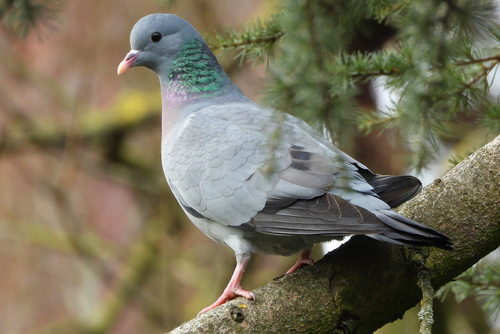
Stock Dove
The Stock Dove (Columba oenas) is a member of the Columbidae family, which includes pigeons and doves. Often overshadowed by its more common relatives like the Wood Pigeon and Feral Pigeon, the Stock Dove is a subtly beautiful and ecologically important bird. It plays a role in seed dispersal and serves as prey for various raptors. Unlike many pigeon species, it is not typically associated with urban environments, preferring woodlands, parklands, and agricultural areas with mature trees. There is no known cultural signifigance.
28-33 cm
Length
60-66 cm
Wingspan
Least Concern
Conservation Status
Distribution
The Stock Dove is found across Europe, extending into western Asia and parts of North Africa. Its range stretches from the British Isles and Scandinavia in the north to the Mediterranean region and eastwards into Turkey, Iran, and western Siberia. Some populations are migratory, moving south for the winter.
Lifespan
Typical lifespan in the wild is around 3-5 years, although individuals can live longer.
Stock Dove's Habitat
Habitat Types
Woodlands, Parklands, Farmlands with hedgerows and mature trees, Cliffs and quarries (in some regions)
Climate Zones
Temperate, Boreal (southern edges)
Adaptations
Stock Doves are adaptable to various woodland types, but their reliance on tree cavities for nesting makes mature trees a crucial habitat component. Their relatively short legs and compact build are suited for foraging on the ground in open areas within or near woodlands.
Variations
Several subspecies have been proposed, but differences are often subtle and based on slight variations in plumage coloration or size. More research is needed to clarify the subspecific taxonomy.
Appearance
Breeding Plumage
Plumage is generally similar year-round.
Seasonal Feather Changes
No significant seasonal variations.
Sex Based Plumage Differences
Males and females have very similar plumage. Males may have a slightly more intense iridescence on the neck.
Notable Features
Iridescent green and purple patches on the sides of the neck., Two short, incomplete black wing bars (not extending to the wing edge)., Dark eyes (unlike the red or orange eyes of many other pigeons)., Pinkish-grey breast fading to a paler grey on the belly.
Diet and Feeding
Primary Foods
Seeds, Grains, Cereal crops, Small invertebrates (especially during breeding season), Green plant material (leaves, buds)
Foraging Behavior
Stock Doves primarily forage on the ground, often in open fields or woodland clearings. They peck at seeds and other food items, sometimes forming small flocks, especially outside the breeding season.
Specializations
No highly specialized feeding adaptations, but their relatively strong bill allows them to handle a variety of seed sizes.
Seasonal Diet Variations
Diet can vary depending on the availability of food. In agricultural areas, they may rely heavily on spilled grain after harvest. During the breeding season, they may consume more invertebrates to provide protein for their young.
Behavior
Social Structure
Stock Doves are often seen in pairs during the breeding season but can form small flocks outside of breeding, especially at good feeding sites.
Communication
A soft, cooing vocalization ('oo-roo-oo')., Wing-clapping during display flights.
Migration
Some populations are migratory, while others are resident. Northern and eastern European populations tend to migrate south for the winter, while those in western and southern Europe are more sedentary.
Territorial or Group Behaviors
They defend a small territory around the nest site during breeding. Outside of the breeding season, they are generally not strongly territorial.
Conservation
Threats
Habitat loss (loss of mature trees with suitable nesting cavities)., Changes in agricultural practices (reduced availability of spilled grain)., Hunting (in some parts of their range).
Protection Programs
General wildlife protection laws in many European countries., Habitat conservation efforts aimed at preserving mature woodlands.
Local National Laws
Protected under various national wildlife laws across its range.
Population Trend
Stable
Population Estimates
The global population is estimated to be in the millions, with Europe being a stronghold.
Interesting Facts
The Stock Dove is often mistaken for other pigeon species.
Its relatively plain plumage and lack of distinctive features like the white wing patches of the Wood Pigeon can make identification challenging.
They are one of the few pigeon species that rely heavily on tree cavities for nesting.
This makes them vulnerable to the loss of mature woodlands.
Stock Doves are known to form pair bonds that can last for multiple breeding seasons.
This monogamous behavior is common in many pigeon and dove species.
Faqs about Stock Dove
What is the difference between a Stock Dove and a Wood Pigeon?
Stock Doves are smaller than Wood Pigeons and lack the Wood Pigeon's white neck patches and prominent white wing bars. Stock Doves also have dark eyes, while Wood Pigeons have yellow or orange eyes.
Are Stock Doves common in gardens?
Stock Doves are less likely to be found in gardens than some other pigeon species, preferring more rural or wooded habitats. However, they may visit gardens in areas close to their preferred habitat, especially if there are mature trees and suitable feeding opportunities.
Do Stock Doves migrate?
Some populations of Stock Doves are migratory, particularly those in northern and eastern Europe. These birds move south for the winter to avoid harsh weather and food shortages. Populations in western and southern Europe are often resident.
Copyright @ Nature Style Limited. All Rights Reserved.
 English
English